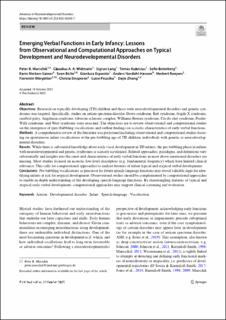Emerging Verbal Functions in Early Infancy: Lessons from Observational and Computational Approaches on Typical Development and Neurodevelopmental Disorders
Marschik, Peter B.; Widmann, Claudius A. A.; Lang, Sigrun; Kulvicius, Tomas; Boterberg, Sofie; Nielsen-Saines, Karin; Bölte, Sven; Esposito, Gianluca; Nordahl-Hansen, Anders; Roeyers, Herbert; Wörgötter, Florentin; Einspieler, Christa; Poustka, Luise; Zhang, Dajie
Peer reviewed, Journal article
Published version
Date
2022Metadata
Show full item recordCollections
Original version
Advances in Neurodevelopmental Disorders. 2022, 6, 369–388. 10.1007/s41252-022-00300-7Abstract
Objectives. Research on typically developing (TD) children and those with neurodevelopmental disorders and genetic syndromes was targeted. Specifcally, studies on autism spectrum disorder, Down syndrome, Rett syndrome, fragile X syndrome, cerebral palsy, Angelman syndrome, tuberous sclerosis complex, Williams-Beuren syndrome, Cri-du-chat syndrome, PraderWilli syndrome, and West syndrome were searched. The objectives are to review observational and computational studies on the emergence of (pre-)babbling vocalisations and outline fndings on acoustic characteristics of early verbal functions. Methods. A comprehensive review of the literature was performed including observational and computational studies focusing on spontaneous infant vocalisations at the pre-babbling age of TD children, individuals with genetic or neurodevelopmental disorders. Results. While there is substantial knowledge about early vocal development in TD infants, the pre-babbling phase in infants with neurodevelopmental and genetic syndromes is scarcely scrutinised. Related approaches, paradigms, and defnitions vary substantially and insights into the onset and characteristics of early verbal functions in most above-mentioned disorders are missing. Most studies focused on acoustic low-level descriptors (e.g. fundamental frequency) which bore limited clinical relevance. This calls for computational approaches to analyse features of infant typical and atypical verbal development. Conclusions. Pre-babbling vocalisations as precursor for future speech-language functions may reveal valuable signs for identifying infants at risk for atypical development. Observational studies should be complemented by computational approaches to enable in-depth understanding of the developing speech-language functions. By disentangling features of typical and atypical early verbal development, computational approaches may support clinical screening and evaluation.

